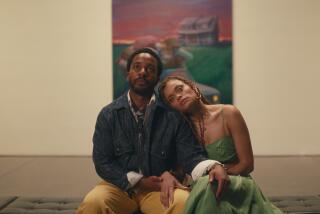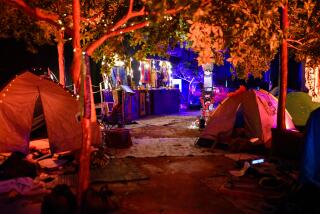Grief and Joy Unfold in Performance
- Share via
Seated on the floor, nude, her knees folded to her chest and her forehead pressed to her knees, the artist begins to unfurl. Her transition from the tight knot of grief to the supple pose of happiness appears on video as a simple, deliberate change of position. This shift serves as an emblem for the much longer, more involved emotional journey that Aviva Rahmani embarked on after the death of her father.
They hated each other for most of their lives, she states on the video, part of her exhibition, “Requiem,” at Grossmont College’s Hyde Gallery (8800 Grossmont College Drive, through Oct. 4). At the very end of his bout with cancer, however, they came to forgive and love each other. She cleansed herself of the hatred and rejection he had tormented her with since childhood. He took her hand, kissed it, and said, “You are my friend.”
On the day his body was flown from New York to Israel for burial, Rahmani began a yearlong Requiem for her father, a “mass for the dead that facilitates acceptance for the living.” Each day she would meditate for 366 minutes on the balance between grief and happiness. On the first day, grief would consume 365 minutes, leaving only one minute for happiness. Each subsequent day, she would subtract one minute of grief and add one of happiness. At the end of the year, the balance was completely reversed, leaving only one minute to focus on grief, followed by 365 minutes of meditation on “the persistence of beauty, kindness, courage, the spiritual and the humorous in life.”
Rahmani, a New York artist who has worked on performance projects for over two decades, calls “Requiem” a performance, but the term fails to convey how seamlessly her art and her life were fused during that year, from late 1987 to late 1988. Rather than an isolated act, contrived for an audience, Rahmani’s performance consisted of a constant, self-conscious scrutiny of her daily life and the recording, both verbally and visually, of the increments of change experienced along the way.
The drawings, prints, photographs and texts at Hyde Gallery, the largest show of the work to date, document and interpret her healing process. Neither coolly analytical nor passionately melodramatic, Rahmani’s tone remains even--introspective, but accessible. She avoids the air of self-indulgence typical of much intensely autobiographical art by withholding excessive details of her days and instead focusing on the meaning culled from her experiences.
Her wall panels read like diary entries, with short texts accompanied by related snapshots or drawings. The texts, a melange of memories, reflections and hopes, are absorbing and often poignant. She writes of the birth of a friend’s child, the AIDS-related death of another friend’s lover and a homeless man’s disappearance from her neighborhood with sensitivity and a tenderness that invests these occurrences with deep emotional impact.
Rahmani seldom refers directly to her father and the abuse he inflicted upon her, but his presence in her psychic makeup clearly drives this project. He appears once in a pastel drawing as a ghostly, skeletal figure in a hospital bed. In a set of etchings, Rahmani refers obliquely to his memory and the stubborn history that separated them. “Am I a rock?” she asks in the title of one print bearing the image of a single stone. “River rocks get worn smooth and round,” she captions another, as if wishing that her pain and rough edges, too, would be eroded naturally by the gentle rush of time.
Rahmani’s prints are delicate but undistinguished, and the pastels, executed every 10 days during the year to mark the shift in balance between grief and happiness, are the weakest elements in the “Requiem” ensemble. Drawing rapidly and casually, Rahmani fills her pages with colorful patterns, notes, sketches and scribbles, none of which carry as much weight as her texts.
Because only a fraction of the daily Requiem texts is included here, Rahmani’s evolution from shame and silence to empowerment is difficult to track. A complete compilation, in book form, would seem the optimal format for Rahmani’s work, for her cathartic journey takes time to absorb. Such a publication is planned, and Rahmani is also in the process of adding a series of paintings to the “Requiem” ensemble. Rahmani’s commitment to the project is impressive, even if aspects of the work are not. A synergistic effect makes up for these lapses, however, and imbues her struggle to overcome pain and loss with universal relevance.
More to Read
The biggest entertainment stories
Get our big stories about Hollywood, film, television, music, arts, culture and more right in your inbox as soon as they publish.
You may occasionally receive promotional content from the Los Angeles Times.










